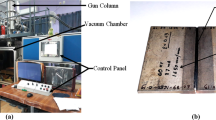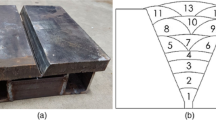Abstract
Welding residual stresses are considered as significant factors for the reduction of fatigue life and load bearing of welded structures. In this article, characterization of a low-temperature stress-relief method called vibratory stress relief process was investigated. In this regard, welding of a butt joint of two steel plates was simulated and induced welding residual stresses were calculated. An experimental residual stress measurement was conducted to verify the numerical results. It was established that the simulated residual stresses are in good agreement with the measured results obtained from the hole drilling strain gauge measurements. In the following, the vibratory stress relief process of the welded joint was simulated using finite element method (FEM). It was observed that by controlling the process parameters, a notable reduction in the residual stress is achievable. Effects of magnitude and frequency of the cyclic force on the effectiveness of the stress relief process were studied. The results indicated that by increasing the applied load frequency up to 95% of the natural frequency, the longitudinal residual stress decreased more than 80%. Also, it has been shown that by increasing the force magnitude, the welding residual stresses were reduced drastically.
Similar content being viewed by others
References
Zargar SH, Farahani M, Besharati Givi M (2016) Numerical and experimental investigation on the effects of submerged arc welding sequence on residual distortion of fillet welded plates. Proc Inst Mech Eng B J Eng Manuf 230:654–661. https://doi.org/10.1177/0954405414560038
Farahani M, Sattari-Far I, Akbari D, Alderliesten R (2012) Numerical and experimental investigation of the effects of residual stresses on crack behavior in aluminum 6082-T6. Proc Inst Mech Eng C J Mech Eng Sci 226:2178–2191. https://doi.org/10.1177/0954406211432667
Farahani M, Sattari-Far I, Akbari D, Alderliesten R (2013) Effect of residual stresses on crack behavior in single edge bending specimen. Fatigue Fract Eng Mater Struct 36:115–126. https://doi.org/10.1111/j.1460-2695.2012.01704.x
Yu C, Chen Z, Wang J, Yan S, Yang L (2012) Effect of welding residual stress on plastic buckling of axially compressed cylindrical shells with patterned welds. Proc Inst Mech Eng C J Mech Eng Sci 226:2381–2392. https://doi.org/10.1177/0954406211433976
Sabokrouh M, Hashemi I, Farahani MR (2015) Experimental study of weld microstructure properties in assembling of natural gas transmission pipeline. Proc Inst Mech Eng B J Eng Manuf 229(4):580–590. https://doi.org/10.1177/0954405415579581
Claxton RA (1974) Vibratory stress relieving - its advantages and limitations as an alternative to thermal treatment. Heat Treat Met 1:131–137
Dawson R, Moffat DG (1980) Vibratory stress relief: a fundamental study of its effectiveness. J Eng Mater Technol 102:169–176. https://doi.org/10.1115/1.3224793
Gnirss G (1988) Vibration and vibratory stress relief. Historical development, theory and practical application. Weld World 26:284–291
Luh C, Hwang RM (1998) Evaluating the effectiveness of vibratory stress relief by a modified hole-drilling method. Int J Adv Manuf Technol 14:815–823. https://doi.org/10.1007/BF01350766
Munsi A, Waddell AJ, Walker CA (2001) Vibratory stress relief—an investigation of the torsional stress effect in welded shafts. J Strain Anal Eng Des 36:453–464. https://doi.org/10.1243/0309324011514610
Munsi A, Waddell AJ, Walker CA (2001) Modification of welding stresses by flexural vibration during welding. Sci Technol Weld Join 6:133–138. https://doi.org/10.1179/136217101101538668
Munsi A, Waddell AJ, Walker CA (2001) Modification of residual stress by post-weld vibration. Mater Sci Technol 17:601–605. https://doi.org/10.1179/026708301101510294
Kuang L (2002) Finite element prediction of residual stress relief in a two-dimensional cantilever beam. Dissertation, Alfred University
Aoki S, Nishimura T, Hiroi T, Hirai S (2007) Reduction method for residual stress of welded joint using harmonic vibrational load. Nucl Eng Des 237:206–212. https://doi.org/10.1016/j.nucengdes.2006.06.004
Zhao XC, Zhang YD, Zhang HW, Wu Q (2008) Simulation of vibrational stress relief after welding based on FEM. Acta Metall Sin (Engl Lett) 21:289–294. https://doi.org/10.1016/S1006-7191(08)60051-4
Kwofie S (2009) Plasticity model for simulation, description and evaluation of vibratory stress relief. Mater Sci Eng A 516:154–161. https://doi.org/10.1016/j.msea.2009.03.014
Kwofie S (2011) Description and simulation of cyclic stress-strain response during residual stress relaxation under cyclic load. Procedia Eng 10:293–298. https://doi.org/10.1016/j.proeng.2011.04.051
Wang JS, Hsieh CC, Lin CM, Chen EC, Kuo CW, Wu W (2014) The effect of residual stress relaxation by the vibratory stress relief technique on the textures of grains in AA 6061 aluminum alloy. Mater Sci Eng A 605:98–107. https://doi.org/10.1016/j.msea.2014.03.037
Akbari D, Farahani MR, Soltani N (2012) Effects of the weld groove shape and geometry on residual stresses in dissimilar butt-welded pipe. J Strain Anal Eng Des 47:73–82. https://doi.org/10.1177/0309324711434681
Farahani M, Sattari-Far I (2011) Effects of residual stresses on crack-tip constraints. Scientia Iranica B 18:1267–1276. https://doi.org/10.1016/j.scient.2011.11.024
Sattari-Far I, Farahani MR (2009) Effects of the weld groove shape and pass number on residual stresses in butt-welded pipes. Int J Press Vessel Pip 86:723–731. https://doi.org/10.1016/j.ijpvp.2009.07.007
Hilber HM, Hughes TJR, Taylor RL (1977) Improved numerical dissipation for time integration algorithms in structural dynamics. Earthq Eng Struct Dyn 5:283–292
Rao D, Wang D, Chen L, Ni C (2007) The effectiveness evaluation of 314L stainless steel vibratory stress relief by dynamic stress. Int J Fatigue 29:192–196. https://doi.org/10.1016/j.ijfatigue.2006.02.047
Jurcius A, Valiulis AV, Cernasejus O et al (2010) Influence of vibratory stress relief on residual stresses in weldments and mechanical properties of structural steel joint. J Vibroengineering 12(1):133–141
Author information
Authors and Affiliations
Corresponding author
Rights and permissions
About this article
Cite this article
Ebrahimi, S.M., Farahani, M. & Akbari, D. The influences of the cyclic force magnitude and frequency on the effectiveness of the vibratory stress relief process on a butt welded connection. Int J Adv Manuf Technol 102, 2147–2158 (2019). https://doi.org/10.1007/s00170-019-03288-y
Received:
Accepted:
Published:
Issue Date:
DOI: https://doi.org/10.1007/s00170-019-03288-y




